Gone are the days when simply marketing your product would entice the user to come to you. Today, a user is not only looking for service, but they are also seeking convenience.
There’s no better way to reach them than by developing an app that allows them to access your products/services anytime, anywhere through their smartphone.
iOS app development allows you to reach a wide spectrum of users who are a part of Apple’s ecosystem.
With millions of iOS users worldwide, developing your own iOS app and reaching out to the masses becomes super-easy.
But how does iOS app development work? What are the steps involved in building an iOS app?
More importantly, why choose iOS app development, considering Android app development is also an available option?
In this post, we will discuss the answers to each of these questions and more, hence make sure you read it till the end!
Without further ado, let’s start by understanding the basics of iOS app development.
iOS App Development Overview
The term “iOS app development” refers to the process of creating applications specifically for Apple’s iOS operating system. If we talk about the iOS app market, the stats are highly promising as-
- Apple’s App Store has the highest number of apps, 1,990,284, making it the biggest vendor of apps on the planet.
- With more than $1 trillion in billings and sales, Apple clearly indicates that users tend to pay for apps and subscriptions more when they are using iOS.
- The Apple App Store’s revenue for the second quarter year 2024(Q2) was reported to be $24.6 billion, giving a snapshot of how beneficial joining the App Store can be.
This specialized branch of software development requires a comprehensive understanding of both the iOS ecosystem and the programming languages and tools used to build apps that are both efficient and user-friendly.
iOS app development is governed by a variety of best practices and guidelines. This is done to ensure that applications not only perform well but also offer a seamless user experience.
Apple’s Human Interface Guidelines provide a framework for designing intuitive and aesthetically pleasing interfaces while maintaining consistency across the platform.
In summary, iOS app development is a proactive and intricate endeavor that combines innovative software engineering with stringent adherence to Apple’s platforms and user experience principles.
Benefits of iOS App Development over Android
iOS is one of the two major mobile app platforms, the other one being Android.
Android has a larger user base, it’s way more versatile, and offers more customization, so why should you use iOS for app development?
Well, developing iOS applications has its own benefits.
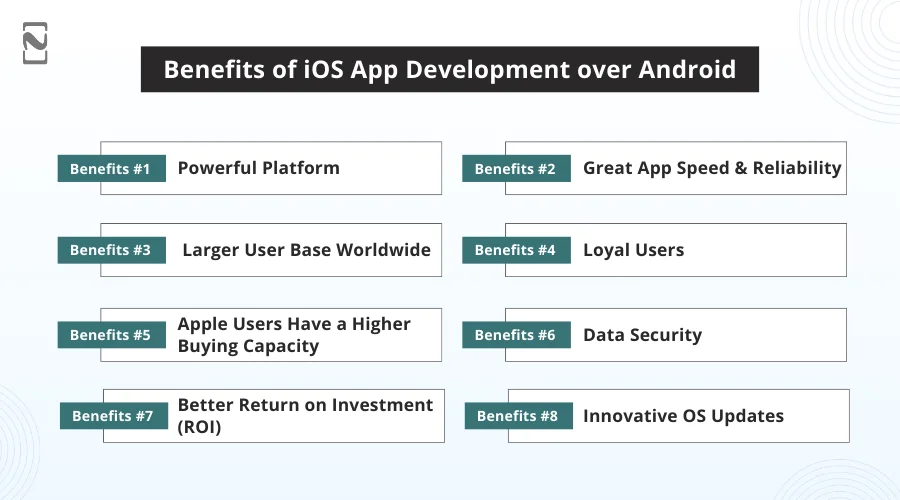
Let’s see what these are:
♦ Powerful Platform
iOS stands as a formidable platform for mobile app development, offering developers an ecosystem that is both robust and user-friendly.
With its advanced programming languages, such as Swift and Objective-C, Apple has cultivated an environment.
Here, iOS app developers can create highly functional and aesthetically pleasing applications.
♦ Great App Speed and Reliability
Performance is paramount in the mobile realm, and iOS excels in this department.
Apps developed for iOS are known for their speed and reliability, resulting in a seamless user experience.
The optimized integration between software and hardware ensures that applications run smoothly, even under demanding conditions.
♦ Larger User Base Worldwide
As of 2023, iOS boasts a significant global user base. Today, this number is larger than ever.
The operating system has consistently topped the charts in numerous regions, making it an attractive option for developers aiming to reach a vast audience.
The widespread adoption is a testament to Apple’s brand loyalty and market penetration, particularly in developed nations.
♦ Loyal Users
While Android has more users, Apple’s user base is renowned for its loyalty.
iOS users often remain within the Apple ecosystem, meaning that once they download an app, they are more likely to use it consistently.
This enthusiasm for Apple products translates to higher engagement rates for apps developed for iOS, making it a lucrative opportunity for developers.
♦ Apple Users Have a Higher Buying Capacity
Research has demonstrated that iOS users possess a greater purchasing power compared to their Android counterparts.
This higher income bracket translates to a stronger propensity to spend on apps, in-app purchases, and subscriptions.
For developers, this presents an unparalleled opportunity for monetization and profit generation.
♦ Data Security
Security is a critical concern in today’s digital landscape, and again, Apple’s application development is known for its amazing security.
With features like end-to-end encryption and stringent app review processes, iOS ensures that user data remains protected.
This commitment to the security of mobile apps not only enhances user trust but also safeguards developers against potential liability issues.
♦ Better Return on Investment (ROI)
One of the first things a business looks for is return on investment.
And speaking of investing in iOS app development, it typically yields a higher ROI.
Given the loyal and affluent user base, along with the superior performance and security features, iOS app developers can expect their apps to generate more revenue over time.
The potential for lucrative returns makes iOS an enticing platform for app development initiatives.
♦ Innovative OS Updates
Last but not least, updates.
Apple is notorious for its commitment to innovation, regularly rolling out updates that enhance functionality and introduce new features.
This ongoing development ensures that apps built for iOS remain relevant and competitive in a rapidly evolving market.
Developers can leverage these updates to improve the user experience and incorporate the latest technology trends.
Choosing an iOS mobile app development platform is a strategic decision grounded in practicality, performance, and user engagement.
With its powerful platform, loyal user base, and commitment to security, iOS not only offers a promising environment for app creation but also maximizes the potential for financial success.
iOS App Development Tools You Need to Know
To help you make the most out of the benefits and achieve the best results when building an iOS app, we can offer you a list of necessary tools that you will require.
You see, no iOS app development guide would be complete without discussing the set of tools required for development.
After all, in the fast-evolving realm of mobile app development services, mastering the right set of tools is critical for developing high-quality iOS applications.
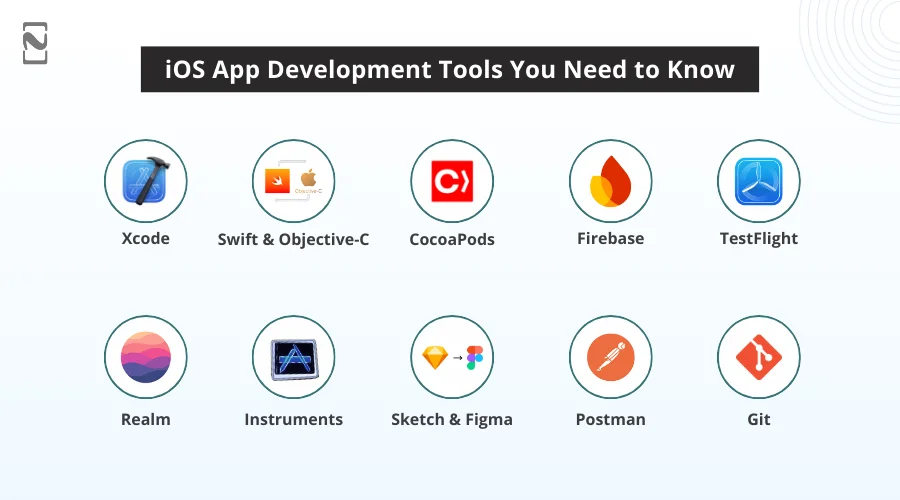
Let’s take a look at all the necessary tools that one might need to work with when developing an iOS app –
1] Xcode
At the heart of iOS app development lies Xcode, Apple’s official IDE.
This comprehensive suite provides developers with everything they need to create, debug, and optimize apps.
It includes a code editor, interface builder, and a rich set of tools for performance analysis.
With features like SwiftUI for building user interfaces swiftly and intuitively, Xcode remains indispensable for both beginners and seasoned developers.
2] Swift and Objective-C
Swift, Apple’s modern programming language, is the preferred choice due to its safety features and performance.
However, understanding Objective-C is still vital, particularly for maintaining legacy applications.
While many tend to compare Swift and Objective-C before choosing which one to learn, mastering both gives developers a robust foundation and flexibility when tackling diverse projects.
3] CocoaPods
For effective dependency management, CocoaPods is the go-to tool.
This library dependency manager simplifies the process of integrating third-party libraries into your project, allowing developers to enhance functionality without reinventing the wheel.
Familiarizing oneself with CocoaPods can significantly expedite the development process.
4] Firebase
Firebase, Google’s mobile platform, is a powerful backend-as-a-service solution that offers an array of functionalities such as real-time databases, authentication services, and analytics.
It enables developers to focus on frontend work while providing a robust environment for backend needs.
Its seamless integration with iOS development makes it an invaluable tool.
5] TestFlight
Testing is crucial for delivering a polished product.
TestFlight is Apple’s solution for beta testing, allowing iOS app developers to distribute their apps to testers and gather valuable feedback before the official launch.
Utilizing TestFlight ensures that bugs are identified early, leading to higher-quality applications.
6] Realm
As a mobile database alternative to Core Data, Realm offers a straightforward and efficient way to handle local data storage.
Its ease of use and rapid performance make it ideal for applications that require persistent data management.
Familiarity with Realm can significantly enhance an app’s performance when managing data-intensive tasks.
7] Instruments
Part of the Xcode toolchain, Instruments provides developers with sophisticated performance analysis and debugging capabilities.
This powerful tool helps identify memory leaks, performance bottlenecks, and other critical issues that can affect user experience.
Using Instruments effectively is essential for optimizing app performance.
8] Sketch and Figma
User experience is paramount in mobile app development.
Design tools like Sketch and Figma facilitate the creation of user interfaces and prototypes. They allow for collaboration among teams and help in quickly iterating on design concepts.
Mastery of these tools is crucial for ensuring that your app is both functional and visually appealing.
9] Postman
For developers working with APIs, Postman is an essential tool for testing and understanding API interactions.
It enables you to send requests, inspect responses, and efficiently manage your API workflows.
Grasping its functionality can streamline the development process significantly.
10] Git
Version control is a cornerstone of modern software development.
Git, especially when integrated with platforms like GitHub or GitLab, enables iOS app developers to track changes, collaborate with team members, and manage code efficiently.
Mastery of Git is critical for any serious developer.
In the competitive world of iOS apps, leveraging the right tools can mean the difference between mediocrity and excellence.
By equipping yourself with the above resources, you’ll be well on your way to creating top-notch iOS applications that stand out in the crowded marketplace.
Dedication to mastering these tools will not only enhance your skills but also solidify your reputation in the industry as a capable and innovative developer.
Knowing these tools can also help you hire iOS app developers in a more effective way
Steps to Build an iOS Mobile App
With all the tools and information available to you, it is now time to explore the steps involved in the iOS app development process.
While it seems that a developer or a team of app developers can get the job done instantly, there are a series of steps that make up a robust iOS app.
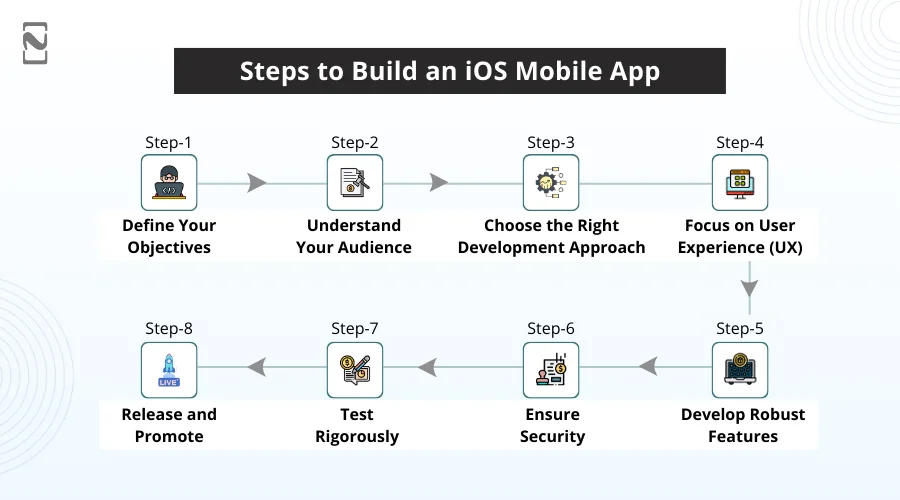
Here are the steps that one has to follow –
Step 1: Define Your Objectives
Establish clear goals for your app. Identify whether you are looking to increase sales, improve customer service, or streamline internal operations.
When your objectives are clear, you have a whole lot of room to explore the available options that can help you achieve better results.
Step 2: Understand Your Audience
After you have understood your objectives, it is time to understand what your users are looking for. Conduct thorough market research to assess your target demographic.
Understanding their needs, preferences, and pain points will help you design an intuitive app that resonates with them.
Tools like surveys, focus groups, and user interviews can provide valuable insights.
Step 3: Choose the Right Development Approach
When starting iOS app development, it is crucial to understand what approach you will be taking.
If you plan to build an app that solely works for the iOS device, you should go for a native development approach, while if you want to create a single code-base that works for both iOS and Android, opting for a cross-platform approach is more understandable.
Here are some different approaches you can explore.
- Native Development: This is the gold standard for performance and user experience, utilizing Swift or Objective-C. Native apps deliver superior speed and responsiveness.
- Cross-Platform Development: Frameworks like React Native or Flutter allow you to write code once and deploy it on multiple platforms. This can save time and cost, but may compromise some native performance.
- Low-Code/No-Code Platforms: If speed and simplicity are priorities, consider platforms like AppGyver or OutSystems. These tools in your mobile app tech stack can empower business users to create apps without extensive coding knowledge.
Step 4: Focus on User Experience (UX)
User experience is paramount. Design a clean and engaging interface that prioritizes usability.
Utilize design principles such as simplicity, consistency, and accessibility, which allow your app to have an intuitive navigation and a clutter-free experience while maintaining a uniform brand identity.
Ensure that you refer to the mobile app design guide to ensure everything is done correctly.
Step 5: Develop Robust Features
Consider including features that enhance the functionality of your application. The features of a mobile app, especially in the iOS field, can either make it or break it; therefore, it’s very important to focus on this one.
Make sure you integrate the best features without making your app too cluttered or too minimal. The correct balance of features and functionality is certainly a game-changer for an iOS app.
| Must-Have Features of iOS App | |
| 1. User-Friendly Interface (UI) and Intuitive User Experience (UX) | 6. Push Notifications |
| 2. Fast Loading Speed and High Performance | 7. AI Integration |
| 3. Security & Privacy | 8. Cross-Platform Compatibility |
| 4. Advanced Security and Data Protection | 9. Robust Analytics |
| 5. Compliance with App Store Guidelines | 10. Feedback System |
Step 6: Ensure Security
Security is paramount. With increasing concerns over data privacy, prioritize security measures:
- Data Encryption: Protect sensitive user information through robust encryption methods.
- Secure Authentication: Implement features like two-factor authentication to bolster security.
- Compliance: Ensure that your app adheres to regulations such as GDPR and CCPA, where applicable.
Step 7: Test Rigorously
Conduct thorough testing across various devices and operating systems to identify bugs and gather user feedback.
This can include:
- Usability Testing: Observe real users as they interact with your app to pinpoint pain points.
- Beta Testing: Release a beta version to a limited audience to gain insights before the full launch.
Step 8: Release and Promote
Once testing is complete and you’ve made the necessary adjustments, it’s time to launch your app on the App Store. Create a marketing strategy that includes:
- App Store Optimization (ASO): Optimize your app’s title, description, and keywords to improve visibility in the App Store.
- Social Media Campaigns: Leverage your social channels to create buzz around your app launch.
- Influencer Partnerships: Collaborate with industry influencers to reach a broader audience.
Building an iOS app for business is a multifaceted endeavor that requires careful planning, execution, and ongoing maintenance.
By following this authoritative guide, you position your business to create a valuable tool that enhances the customer experience and drives operational excellence.
In an era where digital engagement dictates success, investing in a well-executed iOS application is not just an option; it’s a strategic imperative.
Things to Keep in Mind for iOS App Development
Before you hire a mobile app development agency, you must make sure that you want to go with iOS app development.
For this, there are various factors that you need to consider.
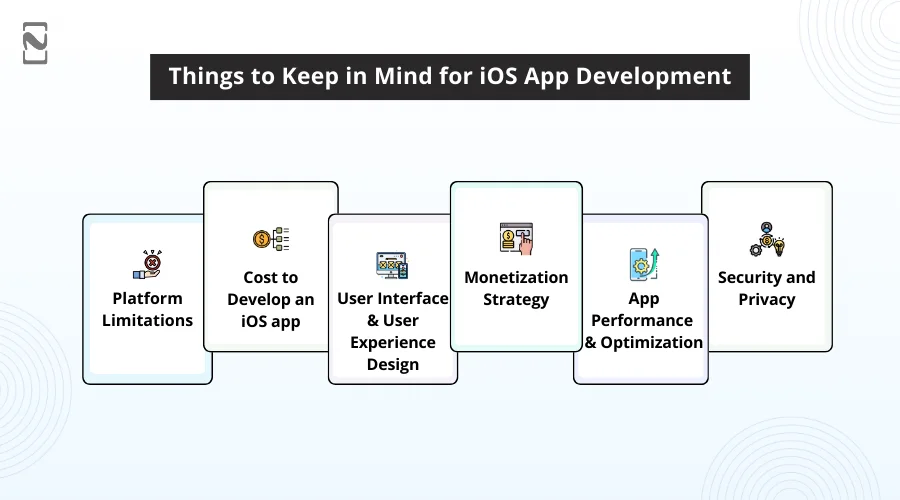
These factors are crucial in choosing the various factors that should be considered; these are, as mentioned below:
-
Platform Limitations
iOS development comes with its own set of rules and limitations, including guidelines set by Apple.
Please familiarize yourself with these requirements and restrictions, as they directly impact user experience and app approval.
-
Cost to Develop an iOS App
Ensuring that the application is built without compromises requires a set budget. Generally, iOS app development costs anywhere from $25,000 & $250,000.
There are several factors that contribute to this range of budgets that you need to consider when building your app.
Hence, you need to consider having a sorted budget for the app development process; otherwise, you might struggle.
-
User Interface and Experience (UI/UX) Design
UI/UX design is crucial on iOS, given Apple’s high standards for aesthetics and functionality.
Prioritize a user-centric design approach; conduct usability tests to refine your interface before launch.
-
Monetization Strategy
We all know how big a revenue-generating iPhone app is.
In order to do this, you need to define how your app will generate revenue. Options include paid downloads, freemium models, in-app purchases, and advertisements.
Your chosen strategy should align with user expectations and market norms.
-
App Performance and Optimization
iOS users expect high performance and speed.
Consider the app’s loading time, responsiveness, battery consumption, and memory usage. Conduct performance testing regularly to optimize app performance on various aspects.
-
Security and Privacy
Ensure that the app adheres to Apple’s strict privacy guidelines.
Implement robust security measures to protect user data, as any breach can lead to devastating consequences, including loss of trust and financial repercussions.
Developing iOS applications involves meticulous planning and execution. By considering these factors, you lay a solid foundation for creating an app that not only meets market demands but also offers a stellar user experience.
In a competitive landscape, attention to detail and a strategic approach are your pathways to success.
How Can We Help You Build High-End iOS Applications?
Developing an iOS app seems to be the ultimate way of targeting the right audience, as per your business. With sorted but strict guidelines, getting hands on a well-built iOS app is certainly typical for any business.
Hence, it is recommended that you hire a professional iOS app development company like Nimble AppGenie.
With years of experience and a team of highly skilled developers and analysts, we can offer a thorough development service, covering everything from research and requirement analysis to final deployment and testing.
We also offer custom iOS app maintenance packages to help you keep your application running without any hiccups.
If you are planning to enter the market with an iOS app of your own, then Nimble AppGenie is certainly your best option. Reach out today to get more insights!
Conclusion
Hope all the information shared in the guide keeps you on track towards building a solid iOS app.
Building an iOS application for your business seems to be highly vital, considering it allows you to reach a wider audience, gives you a better opportunity to earn, and makes the product available across the globe.
While the opportunities are endless, it takes a lot of effort, knowledge, and resources to develop an iOS app, which means you need professional assistance and make multiple decisions when opting for iOS app development for your business.
With several benefits like an optimized app speed, a loyal user base, high security, and innovative OS features, iOS certainly makes it viable to launch an app.
Hence, following the iOS app development process and ensuring that all the factors are considered in this post makes it a one-stop guide for people looking for assistance with the same.
That will be all for this post. Thanks for reading. Good Luck!
FAQs
Some common mistakes to avoid in iOS app development include:
- App Store Approval
- Beta Testing
- Device Compatibility
- Resource Consumption
- App Security
- iOS app design
- iOS app’s high battery consumption
Great monetization strategies for iOS mobile apps include:
- In-app purchases
- In-app ads
- Subscription/freemium model
- Affiliate marketing
The benefits of choosing iOS app development include:
- Powerful Platform
- Great App Speed and Reliability
- Larger User Base Worldwide
- Loyal Users
- Data Security
- Innovative OS Updates
When choosing an iOS app development company, consider the following:
- Define Your Requirements
- Assess Their Experience and Expertise
- Examine Client Reviews and Testimonials
- Explore Their Development Process
- Evaluate Their Design Capabilities
- Ask About Post-Launch Support

Niketan Sharma, CTO, Nimble AppGenie, is a tech enthusiast with more than a decade of experience in delivering high-value solutions that allow a brand to penetrate the market easily. With a strong hold on mobile app development, he is actively working to help businesses identify the potential of digital transformation by sharing insightful statistics, guides & blogs.
Table of Contents




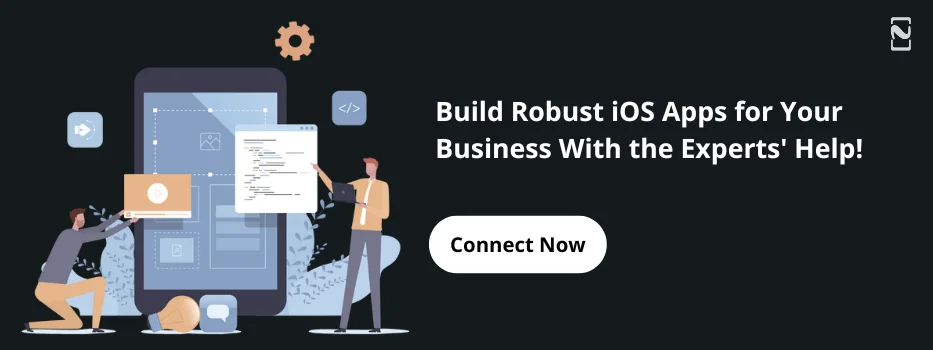

No Comments
Comments are closed.